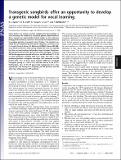| dc.contributor.author | Lois, Carlos | |
| dc.contributor.author | Agate, R. J. | |
| dc.contributor.author | Nottebohm, F. | |
| dc.contributor.author | Haripal, B. | |
| dc.contributor.author | Scott, Benjamin Barnett | |
| dc.date.accessioned | 2010-09-15T18:52:39Z | |
| dc.date.available | 2010-09-15T18:52:39Z | |
| dc.date.issued | 2009-10 | |
| dc.date.submitted | 2009-08 | |
| dc.identifier.issn | 0027-8424 | |
| dc.identifier.issn | 1091-6490 | |
| dc.identifier.uri | http://hdl.handle.net/1721.1/58553 | |
| dc.description.abstract | Zebra finches are widely used for studying the basic biology of vocal learning. The inability to introduce genetic modifications in these animals has substantially limited studies on the molecular biology of this behavior, however. We used an HIV-based lentivirus to produce germline transgenic zebra finches. The lentivirus encoded the GFP regulated by the human ubiquitin-C promoter [Lois C, Hong EJ, Pease S, Brown EJ, Baltimore D (2002) Science 295:868–872], which is active in a wide variety of cells. The virus was injected into the very early embryo (blastodisc stage) to target the primordial germline cells that later give rise to sperm and eggs. A total of 265 fertile eggs were injected with virus, and 35 hatched (13%); 23 of these potential founders (F0) were bred, and three (13%) produced germline transgenic hatchlings that expressed the GFP protein (F1). Two of these three founders (F0) have produced transgenic young at a rate of 12% and the third at a rate of 6%. Furthermore, two of the F1 generation transgenics have since reproduced, one having five offspring (all GFP positive) and the other four offsping (one GFP positive). | en_US |
| dc.description.sponsorship | McKnight Endowment Fund for Neuroscience (McKnight Technological Innovations in Neuroscience Awards) | en_US |
| dc.description.sponsorship | Whitehall Foundation | en_US |
| dc.description.sponsorship | Rockefeller University | en_US |
| dc.language.iso | en_US | |
| dc.publisher | National Academy of Sciences | en_US |
| dc.relation.isversionof | http://dx.doi.org/10.1073/pnas.0909139106 | en_US |
| dc.rights | Article is made available in accordance with the publisher's policy and may be subject to US copyright law. Please refer to the publisher's site for terms of use. | en_US |
| dc.source | PNAS | en_US |
| dc.title | Transgenic songbirds offer an opportunity to develop a genetic model for vocal learning | en_US |
| dc.type | Article | en_US |
| dc.identifier.citation | Agate, R. J. et al. “Transgenic songbirds offer an opportunity to develop a genetic model for vocal learning.” Proceedings of the National Academy of Sciences 106.42 (2009): 17963 -17967. ©2010 by the National Academy of Sciences. | en_US |
| dc.contributor.department | Massachusetts Institute of Technology. Department of Brain and Cognitive Sciences | en_US |
| dc.contributor.department | Picower Institute for Learning and Memory | en_US |
| dc.contributor.approver | Lois, Carlos | |
| dc.contributor.mitauthor | Lois, Carlos | |
| dc.contributor.mitauthor | Scott, Benjamin Barnett | |
| dc.relation.journal | PNAS | en_US |
| dc.eprint.version | Final published version | en_US |
| dc.type.uri | http://purl.org/eprint/type/JournalArticle | en_US |
| eprint.status | http://purl.org/eprint/status/PeerReviewed | en_US |
| dspace.orderedauthors | Agate, R. J.; Scott, B. B.; Haripal, B.; Lois, C.; Nottebohm, F. | en |
| mit.license | PUBLISHER_POLICY | en_US |
| mit.metadata.status | Complete | |
